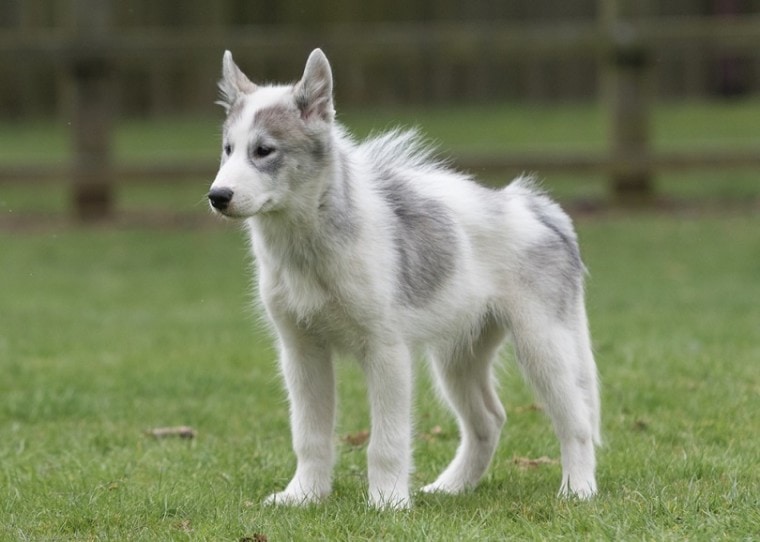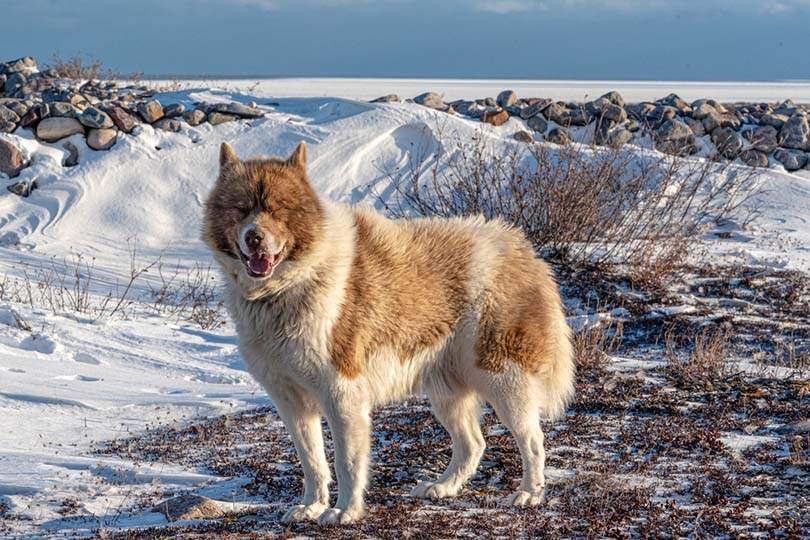
Click Below to Skip Ahead
The Canadian Eskimo Dog — or Inuit Dog, as it is sometimes known — is a hard-working sled dog from the Canadian Arctic. In this barren environment, these dogs were a vital part of the lives of the Inuit people, serving mainly as draught dogs to pull heavy loads and cover massive distances while doing so. They were also commonly used for hunting seals and other animals and were thus an indispensable part of the Inuit people’s lives. Unfortunately, due to the use of motorized snowmobiles and the introduction of other sled dogs, like Siberian Huskies, the numbers of Canadian Eskimo dogs dropped dramatically from over 20,000 to near extinction by the early 1960s. Luckily, due to the hard work of dedicated breeders, the breed has come back from the brink, but only just, as the numbers worldwide are still relatively low.
Breed Overview
Height:
24 – 29 inches
Weight:
40 – 80 pounds
Lifespan:
12 – 15 years
Colors:
White, brown, red, grey, or sable
Suitable for:
Active owners, active families, sledding, hunting
Temperament:
Affectionate, intelligent, courageous, loyal, energetic, active
These dogs are beautiful animals, with thick coats, stocky builds, and almost endless energy and stamina. They have gorgeous almond-shaped brown eyes and the characteristic curled-over tail of arctic dogs. They are intelligent, energetic, and powerful animals that need an experienced owner to train and look after and are known to have an independent and somewhat stubborn nature.
If you’d like to know more about these rare, beautiful dogs, read on!
Canadian Eskimo Dog Characteristics
Canadian Eskimo Puppies
Before you take the leap and bring home a Canadian Eskimo puppy, you need to be aware that these dogs are extremely energetic animals, and without regular intensive exercise, they can quickly become bored, which may cause destructive behavior, like digging and chewing, and possibly even aggressive behavior. These dogs are not happy to sit on the sofa all day, and they require a massive investment in time for exercise and training.
Temperament & Intelligence of the Canadian Eskimo Dog
The Canadian Eskimo Dog is a true working breed: reliable, loyal, and intelligent. They are affectionate dogs too and make wonderful companions that form close bonds with their owners. These dogs are highly pack-orientated and will challenge their owner when given the opportunity, so it’s vital to establish yourself as the pack leader early on in your relationship. They are animals with extremely high amounts of energy that need an outlet — they thrive off of having a job to do — and without proper exercise, they can quickly become destructive and even aggressive.
They can be vocal dogs at times, howling and barking at every opportunity. This can be largely reduced and controlled with proper exercise and training, but you should know that this is also just a natural trait of the breed.
Are These Dogs Good for Families? 👪
Canadian Eskimo Dogs can make wonderful family pets, are loyal and loving with family members, and can display a surprisingly gentle temperament despite their working history. They can be boisterous and overly enthusiastic at times, however, and are usually not recommended for families with young children. Their pack mentality can also be an issue with smaller children, as they may not recognize them as a part of the social hierarchy. That said, with early socialization and training, they are known to make great family pets.
Does This Breed Get Along With Other Pets?
Even though the Canadian Eskimo Dog is a pack-orientated animal, they generally do not do well living with other dogs and are best kept in single-dog homes. They are happy to be around other dogs that are an accepted part of their pack, but any outside dogs are usually seen as a threat. Even within packs, there is the constant battle for hierarchy that can cause fighting at times. They have a strong prey drive too, and small pets will likely be seen as lunch rather than a friend! Again, proper socialization is vital to avoid issues.
Things to Know When Owning a Canadian Eskimo Dog
The Canadian Eskimo Dog can be a handful to own. They are born and bred working dogs, and melding them into domestic life can be a challenge at times. With time and dedication, though, they can make wonderful pets. Read on for extra tips on feeding, exercising, and training your Canadian Eskimo Dog.
Food & Diet Requirements 🦴
As the Canadian Eskimo Dog’s natural diet consists mostly of meat like fish and deer, you should aim to feed your dog as close to this as possible. They’ll need a diet packed with animal protein, ideally fresh, lean meats or high-quality pellets that have animal-sourced protein as the first listed ingredient and are free from filler grains like wheat and corn.
The amount that you feed them will depend on their age, weight, and activity level, but 3-4 cups of dry food per day split into two meals is a good starting point. Always make sure they have access to fresh, clean water at all times.
Exercise 🐕
These dogs have massive amounts of energy and stamina, garnered from centuries of running through miles of expansive terrain for hours pulling heavy weights. Indeed, these dogs can stay active all day long without flinching, and they can be difficult to keep up with. They are not a breed that will be satisfied with a leisurely walk and play session every day and needs more activity than most people can give them. Ideally, you’ll want to enroll them in some form of dog sport to really get them moving regularly or be prepared for 3-4 hours of intensive exercise. Training them to run on a treadmill is an often-recommended method of giving them the stimulation that they need and can be a good last resort. Their thick, woolly coats make them prone to heat exhaustion too, making exercise even more difficult. These dogs are best suited to colder climates.
Training 🎾
Canadian Eskimo Dogs need firm leadership during training, and you’ll need to establish yourself as the pack leader early on to train them successfully. Once you have established yourself at the top of the hierarchy, training these dogs is not as difficult as you’d imagine, and they are usually happy to follow commands and obey orders. They are highly intelligent animals that have spent hundreds of years working closely with humans and don’t need many repetitions to learn commands. Patience, consistency, and a gentle yet firm hand are key to successfully training an Eskimo Dog.
Grooming ✂️
With their thick, luxurious double coats, Canadian Eskimo Dogs need regular brushing to remove dead hair, at least two to three times a week, but preferably every other day. They shed heavily during seasonal changes, and you’ll need to ramp up the brushing to avoid hair getting all over your home. You’ll also want to keep their nails short and trim to avoid breakage and brush their teeth a couple of times a week to avoid dental disease.
Health and Conditions 🏥
Canadian Eskimo Dogs are healthy animals that don’t have any known inheritable genetic diseases. That said, their immune system has been developed in the cold arctic, so they are more susceptible to common dog illnesses and need to have all their necessary shots strictly up to date. Living in cold climates for thousands of years has also made them adapt exceptionally well to the cold, but they also have a high intolerance to heat. They do not do well in warm climates and should ideally be kept in colder parts of the country.
Male vs Female
So, you’ve decided that the energetic Canadian Eskimo Dog is the breed for you, but should you get a male or female? First, it’s important to take into consideration that a dog’s personality is affected largely by their genetics and upbringing, and sex has a far smaller part to play. That said, males are known to be more territorial and thus, more prone to aggression than females, and they will want to assert themselves as the pack leader. Females can be independent at times and often prefer their own space and will come for affection only when they feel the need.
These are just generalizations, though, and spaying and neutering your dog will mitigate most traits that are influenced by sex.
3 Little-Known Facts About the Canadian Eskimo Dog
1. They are an ancient breed
The Canadian Eskimo Dog dates back as far as 4,000 years ago, living and working with the Inuit people of Northern Canada. The dogs were used extensively for sled pulling and hunting and were loyal companions in the harsh terrain.
2. They almost went extinct
The Canadian Eskimo Dog was close to extinction in the 1960s, some believe it was due to the influx of snowmobiles replacing them for transport. However, their extinction scare was mainly a result of a mass slaughter of the dogs lead by RCMP forces under government instruction, a fact which has been hotly debated and written off as conspiracy in some circles. Added to this was the widespread introduction of Huskies to the area, dogs that had more energy and stamina, and eventually replaced the Eskimo dogs.
3. Breeders are bringing them back from the brink
By 1963, there was only one Canadian Eskimo Dog registered with the Canadian Kennel Club (CKC) studbook, and the breed was declared extinct. With support from the Canadian government and the CKC, dedicated breeders began to earnestly bring the breed back by scouring remote areas of the Canadian Arctic to find purebred Eskimo dogs, which they did. A breeding program was launched and populations began to gradually rise.

Conclusion
The Canadian Eskimo dog is a rare beauty, an arctic gem that has a specific set of requirements. They are certainly not the breed for everyone, and it can be a real challenge for even experienced owners to meet the breed’s demands. They have an almost inexhaustible reserve of energy that needs to be given attention, and they seem to be ready for action 24/7. If you are keeping an Eskimo Dog in a domestic environment, this can be an almost impossible bar to meet, and otherwise, these dogs can become destructive and aggressive. Firm, confident training is also essential and requires a ton of patience and dedication, but once you are established as the pack leader, these dogs are surprisingly easy to train.
If you have the patience, time, and dedication and are lucky enough to find one of these beautiful dogs, they make truly one-of-a-kind pets and will reward you with years of love, loyalty, and protection.
Related Reads:
Featured Image Credit: Karen Appleby, Shutterstock








